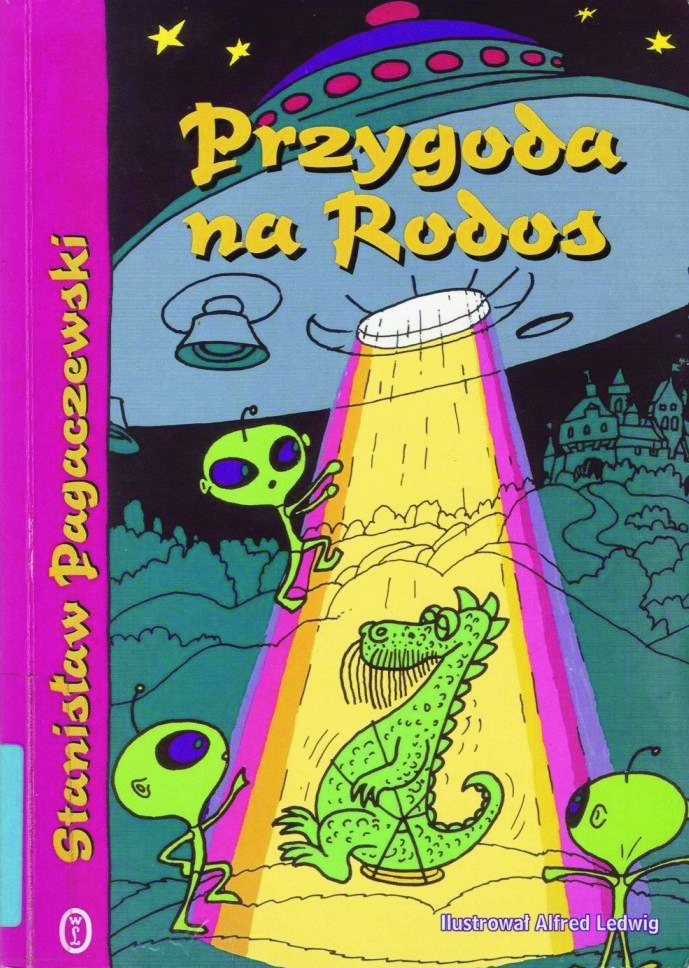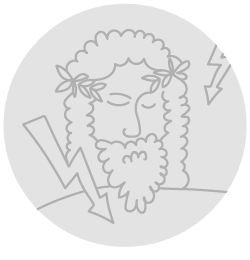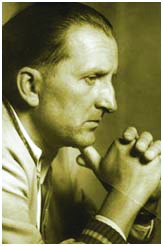Title of the work
Country of the First Edition
Country/countries of popularity
Original Language
First Edition Date
First Edition Details
Stanisław Pagaczewski, Przygoda na Rodos. Kraków: Wydawnictwo Literackie, 1982, 179 pp.
ISBN
Genre
Fantasy fiction
Novels
Target Audience
Children
Cover

Edition from 2002, courtesy of Wydawnictwo Literackie.
Author of the Entry:
Summary: Daria Pszenna, University of Warsaw, dariapszenna@student.uw.edu.pl
Analysis: Marta Pszczolińska, University of Warsaw, m.pszczolinska@al.uw.edu.pl
Peer-reviewer of the Entry:
Katarzyna Marciniak, University of Warsaw, kamar@al.uw.edu.pl
Elżbieta Olechowska, University of Warsaw, elzbieta.olechowska@gmail.com

Alfred Ledwig (Illustrator)

Photograph courtesy of Czesław Białczyński, retrieved from the website dedicated to the Author (accessed: September 28, 2020).
Stanisław Pagaczewski
, 1916 - 1984
(Author)
Born and educated in Cracow. MA in Polish philology at the Jagiellonian University. Member of Polish Writers’ Union. During WW2 he was hiding from the Gestapo because of his involvement in underground education. After the war worked as a journalist and writer, mainly of books for children; also wrote poetry. An enthusiast of Polish mountains, he wrote several guidebooks and was an active member of the Polskie Towarzystwo Turystyczno-Krajoznawcze [Polish Tourist and Sightseeing Society]. For his children’s books he was awarded the Order of the Smile – an international award given by children to adults for their pro-children activities. Among his books, the most popular is the trilogy about the adventures of the Wawel Dragon (Smok Wawelski) and his friends: Porwanie Baltazara Gąbki [Abduction of Baltazar Gąbka], 1965; Misja profesora Gąbki [Mission of Professor Gąbka], 1975, and Gąbka i latające talerze [Gąbka and Flying Saucers], 1979. The books refer to an important Polish legend about Prince Krak (the founder of Cracow) and the Wawel Dragon who lived in a cave at the foot of Wawel Hill and terrorized the city. One day a poor cobbler decided to defeat the monster. He stuffed a lamb with sulphur and placed it in front of the Dragon’s cave. The Dragon ate it and soon became thirsty so he went to the Vistula River and drank and drank until he exploded. The brave man married the Princess, and they lived happily ever after. Pagaczewski made Prince Krak and the Dragon the main characters of his books, changing the legend and presenting Krak and the Dragon as friends. The trilogy was translated into English, French, Hungarian, Japanese, Portuguese, and Slovak. The first and second volumes were made into an animated television show produced by Studio Filmów Rysunkowych Bielsko-Biała [Animated Film Studio in Bielsko-Biała].
Sources:
Website about Pagaczewski and his books (accessed: September 28, 2020).
"Stanisław Pagaczewski", in Lidia Becela, ed., Kto jest kim w Polsce 1984? Informator biograficzny, Warszawa: Interpress, 1984, 711.
Czesław Białczyński, Stanisław Pagaczewski (1916-1984) – autor Przygód Profesora Gąbki – Jego Kraków i Góry Harów, bialczynski.wordpress.com (accessed: September 28, 2020).
Bio prepared by Daria Pszenna, University of Warsaw, dariapszenna@student.uw.edu.pl
Sequels, Prequels and Spin-offs
Stanisław Pagaczewski, Porwanie Baltazara Gąbki, Kraków: Wydawnictwo Literackie, 1966;
Stanisław Pagaczewski, Misja profesora Gąbki. Opowieść o nowej wyprawie, Kraków: Wydawnictwo Literackie, 1975;
Stanisław Pagaczewski, Gąbka i latające talerze, Kraków: Wydawnictwo Literackie, 1979.
Summary
Based on: Katarzyna Marciniak, Elżbieta Olechowska, Joanna Kłos, Michał Kucharski (eds.), Polish Literature for Children & Young Adults Inspired by Classical Antiquity: A Catalogue, Faculty of “Artes Liberales”, Warsaw: University of Warsaw, 2013, 444 pp.
In terms of the plot, this book (an adventure novel with elements of fantasy) can be regarded as a continuation of the trilogy about the adventures of the Wawel Dragon, but the action does not take place in the Middle-Ages but in the 20th century. Moreover the Dragon this time does not appear in person. The reason for its absence is explained in the last volume of the trilogy – the beast was abducted by a UFO. It is only alluded to in conversations. Pagaczewski introduces the reader to an alternative world, where existence of dragons is highly probable and their origin can be found in the ancient Greek myths. In this story mythology becomes a source of information for the origin of dragons. There is even a special organization called International Association for Dragon Research responsible for the research on dragons and for dragon lore (Pol. smokologia). One of the main characters who is also the narrator goes with members of his crew to the Island of Rhodes reputed to be the den of the deadliest ancient dragons, looking for an irrefutable proof of the existence of these creatures. Not surprisingly, and typically for such adventures, there are also pirates and a big treasure. It is the beginning of the search for the mythical dragon land - Smokonia.
Analysis
The book is a typical humorous adventure novel for children. Its positive characters include scientists fascinated by dragons, a writer and a journalist, who ground their search on science and scientific research, even though they refer to a fictional discipline – dragonology. The researchers believe that the dragons present in myths, legends, poems and tales for children in many cultures became an endangered species, exterminated during the middle ages because at that time, there were no rules for preserving the environment. The research is to lead to the discovery of Smokonia – Dragonland, from where the Wawel Dragon’s grandfather came. A sheet showing the outline of an island situated by the Very Blue Sea was found in the book What I Know About My Family, written by the Wawel Dragon. Meanwhile, one of the monastic treaties from the 17th century states that dragons once lived in Asia Minor, Ephesus, Antakya and Rhodes, which rises from very blue waters of the sea; this information suggests to the researchers a Mediterranean direction. Before leaving for Rhodes, the narrator searches the Jagiellonian library for research papers on the history of Greek and Hellenic culture.
The references to Antiquity are not overly abundant. Since the story arc partially takes place in Greece, most of these references relate to places visited by the characters, for example in Athens: although the travelers do not have time for sightseeing, the Acropolis and the Theatre of Dionysus are both named. Similarly, as they are about to go to Crete, the author presents it as the homeland of the Minotaur, who, according to dragonologists, was likely to be a member of a species of man-eating dragons fond of "imported goods" – the tribute of 7 girls and 7 boys from Athens. Pagaczewski also mentions the myth of the labyrinth built by Daedalus, and of Theseus, who managed to escape it with Ariadne’s help. The travellers find a special stone on Rhodes, and it turns out to be a dragon’s tooth of the family dracones maritimes; the dragonologists evoke the myth of Perseus, who, according to them, was to liberate Andromeda not by slaying a sea monster or a snake, but rather a dragon from this family.
Although the story arc revolves around dragons, there is also mention of the goddess Aphrodite when one of the secondary characters, a Frenchman, goes to Cyprus with his guitar. He is heading there for celebrations in honour of Aphrodite, the goddess of beauty and love, and promises to send a postcard to his girlfriend, which would say “not even she is as beautiful as you are”, following stereotypical French courtesy towards women, but also tells the child reader who Aphrodite was.
The references to Antiquity also appear in the linguistic layer – the use of metaphors and proper names. When the protagonists swim in the sea and sunbathe, the scenery is the same as in Antiquity: high in the sky under which Daedalus and Icarus once flew, the sun is shining – the sun that once beat down on Odysseus and his companions. As they drink orange juice after being rescued from the villains, they compare it to the nectar of Olympic gods, and the hotel to which they return is described to glisten like the gunmetal statue of Helios called the Colossus of Rhodes, one of the Seven Wonders of the Ancient Word. The author also uses proper names alluding to Antiquity: the professor who invites the members of the International Association for Dragons Research to the next congress carries the nomen omen, Drakopoulos (from Ancient Greek δράκων, drákōn – a dragon), and the shepherd, who frees the protagonists from restraints, is called "brave Andreios" (ἀνδρεῖος, andreîos – brave, courageous). The author also chose “Apollonius” to be the name of the hotel, usually used in conjunction with the name Rhodes, which is a clear reference to Apollonius of Rhodes.
Further Reading
Białczyński, Czesław, Stanisław Pagaczewski (1916–1984) – autor Przygód Profesora Gąbki – Jego Kraków i Góry Harów, bialczynski.wordpress.com (accessed: September 28, 2020).
"Stanisław Pagaczewski", in: Lidia Becela, ed., Kto jest kim w Polsce 1984? Informator biograficzny, Warszawa: Interpress, 1984, 711.
Sucharski, Robert, "Stanisław Pagaczewski and His Tale(s) of the Wawel Dragon" in: Chasing Mythical Beasts: The Reception of Ancient Monsters in Children’s and Young Adults’ Culture, in the series “Studien zur europäischen Kinder- und Jugendliteratur / Studies in European Children’s and Young Adult Literature” 8, Heidelberg: Universitätsverlag Winter, 2020, 439–449.
Website about Pagaczewski and his books (accessed: September 28, 2020).
Addenda
Entry based on: Kraków: Stanisław Pagaczewski, Przygoda na Rodos, Wydawnictwo Literackie, 2002, 194 pp.


